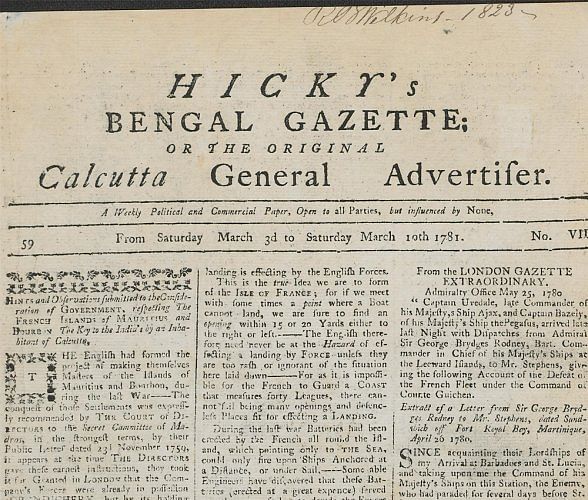
Just as hard as Indians fought for their freedom, one lesser spoken of aspect during the freedom movement was the fourth estate: the Press.
The plight of the Indian citizen who suffered greatly under the British Raj was brought to light by newspapers that did not take well to that reality, in hopes of creating a movement for swaraj.
It began in 1780 with the first printed newspaper in India, the Bengal Gazette. Run by Irishman James Augustus Hicky, the paper was noted and had infamy for its satirical tone and repeated ridicule of the British Raj, something Hicky was proud of and escalated every time he was sued or otherwise impeded by its agents. Unfortunately, the paper ceased to function in 1782, but it left behind quite the legacy.
As time went on, many newspapers took note of the Raj's strategy of using Hindu-Muslim discord as a weapon to distract people from any real attempt at revolting on a nationwide scale. In 1857, during the first war of independence, the newspaper Payam-e-Azadi took to spreading the message that the British would continue to divide and rule and that people had to stand up against it.
Alongside that, existed three newspapers: Samachar Sudhavarashan, Doorbeen and Sultan-ul-Akhbar, which were suppressed for their critical view of the Raj.
The British, of course, never took anything that might threaten their rule lying down. The Raj instituted a number of censorship measures from the early 1800s, at least one of which still survives to this day: the Sedition clause.
But the Sedition clause was alone not enough for the British: they instituted the Vernacular Press Act in 1878, aimed squarely at suppressing non-English papers from criticising the Raj, for the voice against the colonial rule had risen greatly after the famine in 1876.
As though a tit-for-tat, Indian newspapers too refused to take gag orders and threats of prison lying down. Perhaps it was the century-long arduous rule or simply because they were tired of it, the Press soldiered on, using creative means to circumvent censorship. One of the most notable examples of this is Nil Darpan, a play published in The Hindoo Patriot, which was a critical move leading to the Indigo revolt in 1859.
One of the most infamous targets of the Sedition clause was Bal Gangadhar Tilak, who was tried and convicted thrice, one of which was defended - unsuccessfully - by none other than Muhammad Ali Jinnah.
As the nationalist movement gathered steam going into the 1900s, especially after the establishment of the Indian National Congress - which had many prominent newspaper editors in its first sitting and as prominent leaders - the Raj began a major crackdown of the Press by passing one Act after another, like the Prevention of Seditious Meetings Act of 1911, Press Act of 1910, and Criminal Law Amendment Act of 1908. The most disastrous of the Acts passed was the Press Act of 1910, which brought over 1,000 newspapers under prosecution and made the Raj's pockets heavier by Rs 5 lakh in form of securities and forfeitures.
Near the last decades of the Raj, when the Civil Disobedience Movement was well underway and Mahatma Gandhi had taken out the Salt March, the Press (Emergency Powers) Act was passed in 1931 and strengthened during the Second World War. The Act gave provincial governments power to suppress propaganda for the Disobedience movement and was later used as a weapon to ban all talk of Congress.
As the War raged and Indians were drafted into the mess, the press in India formed the All-India Newspapers Editors’ Conference, with the aim to fight for the freedom of the press.
Towards the end of the Raj, though, pre-censorship continued. This was most evident during the 1943 Bengal famine, which was notably reported by the Amrita Bazar Patrika. The Raj went so far as to ban the press from telling the country that it was banned from talking about the famine just so it could be brushed under the rug, possibly owing to the debate that Churchill's animosity towards Indians led to him refusing to grant, or reducing food supplies to the region despite pleas by Louis Mountbatten.
The press, being the ever-clever entity it was, continued its resistance by using underground papers, radio, art and graffiti. This continued till the British finally abdicated from India, creating the two countries - India and Pakistan.